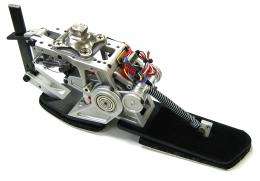Artificial foot recycles energy for easier walking (w/ Video)

(PhysOrg.com) -- An artificial foot that recycles energy otherwise wasted in between steps could make it easier for amputees to walk, its developers say.
"For amputees, what they experience when they're trying to walk normally is what I would experience if I were carrying an extra 30 pounds," said Art Kuo, professor in the University of Michigan departments of Biomedical Engineering and Mechanical Engineering.
Compared with conventional prosthetic feet, the new prototype device significantly cuts the energy spent per step.
A paper about the device is published in the Feb. 17 edition of in the journal PLoS ONE. The foot was created by Kuo and Steve Collins, who was then a U-M graduate student. Now Collins is an associate research fellow at Delft University of Technology in the Netherlands.
The human walking gait naturally wastes energy as each foot collides with the ground in between steps.
A typical prosthesis doesn't reproduce the force a living ankle exerts to push off of the ground. As a result, test subjects spent 23 percent more energy walking with a conventional prosthetic foot, compared with walking naturally. To test how stepping with their device compared with normal walking, the engineers conducted their experiments with non-amputees wearing a rigid boot and prosthetic simulator.
In their energy-recycling foot, the engineers put the wasted walking energy to work enhancing the power of ankle push-off. The foot naturally captures the dissipated energy. A microcontroller tells the foot to return the energy to the system at precisely the right time.
Based on metabolic rate measurements, the test subjects spent 14 percent more energy walking in energy-recycling artificial foot than they did walking naturally. That's a significant decrease from the 23 percent more energy they used in the conventional prosthetic foot, Kuo says.
"We know there's an energy penalty in using an artificial foot," Kuo said. "We're almost cutting that penalty in half."
He explained how this invention differs from current technologies.
"All prosthetic feet store and return energy, but they don't give you a choice about when and how. They just return it whenever they want," Kuo said. "This is the first device to release the energy in the right way to supplement push-off, and to do so without an external power source."
Other devices that boost push-off power use motors and require large batteries.
Because the energy-recycling foot takes advantage of power that would otherwise be lost, it uses less than 1 Watt of electricity through a small, portable battery.
"Individuals with lower limb amputations, such as veterans of the conflicts in Iraq and Afghanistan or patients suffering from diabetes, often find walking a difficult task. Our new design may restore function and reduce effort for these users," Collins said. "With further progress, robotic limbs may yet beat their biological forerunners."
This paper demonstrates that the engineers' idea works. They are now testing the foot on amputees at the Seattle Veterans Affairs Medical Center. Commercial devices based on the technology are under development by an Ann Arbor company.
More information: Paper: dx.plos.org/10.1371/journal.pone.0009307
Provided by University of Michigan

















